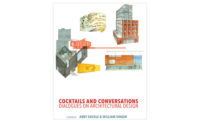Sustainable Design: Ecology, Architecture, and Planning, by Daniel E. Williams, FAIA. Hoboken, New Jersey: John Wiley & Sons, 2007, 304 pages, $75.
High-Performance Building, by Vidar Lerum. Hoboken, New Jersey: John Wiley & Sons, 2007, 304 pages, $70.
The Designer’s Atlas of Sustainability, by Ann Thorpe. Washington, D.C.: Island Press, 2007, 225 pages, $29.95.



We seem to have two camps emerging in the nascent field of sustainable design: an informed one that remains sensitive to the high aims of architecture, ecology, and site, and then one we might call “design services 2.0,” a kind of appliqué of green technologies onto the leftover bin of expired architecture. The literature reflects this, as many books focus on the latter camp, simply exploiting a trendy market. One good exception is the second edition of The HOK Guidebook to Sustainable Design (2005), which has become almost required reading on the subject. There are several books following this how-to approach, all couched in a larger question of what constitutes sustainability. And aside from the more philosophical books, such as Natural Capitalism: Creating the Next Industrial Revolution, by Hawken, Lovins, and Lovins (1999), and McDonough and Braungart’s Cradle to Cradle: Remaking the Way We Make Things (2002), another common route is the detailed technical manual on building performance and technologies. In that genre, the American Society of Heating, Refrigerating, and Air-Conditioning Engineers’s ASHRAE GreenGuide (2006) stands out [RECORD, March 2007, page 172].
Clearly, any new book—and in 2007 there have been many—needs to do something different to stay relevant to the sustainable design community. This is especially true given that the various characteristics of sustainable design—daylight, natural ventilation, and responsible site orientation, to name a few—don’t really change. In the case of the new book, Sustainable Design: Ecology, Architecture, and Planning, by the Seattle architect and urban planner Daniel E. Williams, FAIA, the intended reader is likely an architect new to sustainability, looking to follow up the HOK book. In that respect, Williams serves them well with an authoritative introduction to key issues and terms, most notably a persuasive argument defining sustainable versus green design. For Williams—borrowing conceptually from the theorist Manuel Castells—a sustainable design is one that embeds itself into the “flows” of the natural world, where a building must respond to a changing world. His benchmark is the natural catastrophe: If your building still functions as necessary during a blackout without relying on nonrenewable energy, you are approaching sustainability. Green design, on the other hand, merely concerns itself with efficiency and reducing fossil-fuel dependency.
The second half of Williams’s book includes an overview of the award program of the American Institute of Architects’s Committee on the Environment (AIA/COTE). Williams recounts, in part, each of the 10 annual award-winning projects since the program’s inception in 1997 through 2006. He should know, as he served as chair of AIA/COTE in 2003. A review of case studies included in the book—such as SmithGroup’s 2001 Chesapeake Bay Foundation Headquarters in Annapolis—reveals how important this program has been to sustainable design advocates.
On the other hand, High-Performance Building, by the Illinois architect and educator Vidar Lerum, eschews larger philosophical issues in favor of establishing step-by-step directions for analyzing the performance of existing buildings. Lerum considers performance as “annual specific energy use,” situating that as a base from which architectural form emerges to serve a sustainable end. He then explains his process—including reviewing design documents, talking to the architect and owner, and modeling the building in energy software—for gauging the performance of an existing building, presumably because you, too, would want to analyze an existing building. Like Williams, but with more technical depth, Lerum dedicates the second half of his book to case studies, seven in total, including Morphosis’s 2006 San Francisco Federal Building. While these are helpful, the book’s first half seems misguided and perhaps better directed toward building retrofits, rather than analysis alone.
Ann Thorpe, a design educator in London, seems to establish a separate category of sustainable design book with her Designer’s Atlas of Sustainability, which lays out a broader map of sustainability for designers (though it seems geared toward product design). She looks at terms like “ecology,” “economy,” and “culture” in order to establish a sort of fundamental world view for designers wanting to embrace sustainability. She aims to provide “ingredients rather than recipes,” giving the reader a highly visual and accessible tutorial in subjects as diverse as lifecycle analysis and materials production to the effects of economic globalization and corporate responsibility. Whether these ingredients already pepper your practice depends in large part, according to Thorpe’s agenda, on how much you care. Thus, the book would most help the young student of design, rather than the established professional who is not likely considering something like public sector design for the first time in a career.
That these three worthwhile books fill different niche interests suggests a broader concern—hardly surprising—for sustainable design, but you wonder how we can maintain this publishing cycle and what role it plays in what’s actually getting built (or not). There is enormous talent being poured into thinking about sustainability right now, but you get the feeling that it’s too disconnected and hasty, that many of these books exist more for their authors than for the reader. That most sustainable design literature still begins with a primarily materialist assumption—building new must never stop—while often only briefly mentioning concepts of inhibition, surely lends doubt to any book’s underlying ambitions toward effecting true change.





Post a comment to this article
Report Abusive Comment